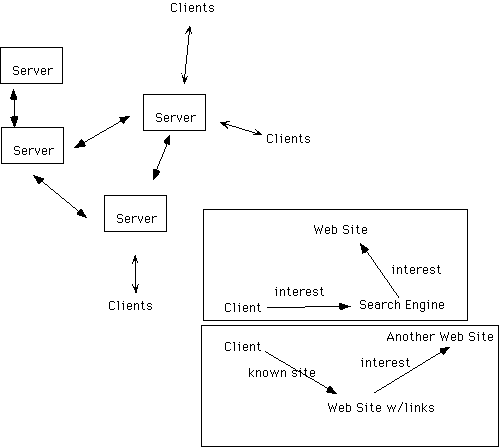

In progress....
1. It's all information In 1949, C. E. Shannon and W. Weaver developed the basic information theory, which was a mathimatical aproach to looking at comunication. The implications of such a theory are far-reaching. To reduce the theory to bare-bones, there is always a transmitter and receiver, as well as a source, and some degree of interference, or noise. Shannon and Weaver also had a final destination. For a more thorough summary, check out a site on information theory For my purposes, I will simplify things a little more. At a less physical level, there is "sender" and "receiver". In most cases, several "transmissions" occur, but each one has to made up of these two poles. Noise is a tougher question. What, after all, is being sent? If I am looking at the world, I have no way of knowing if I am seeing it in the way it "intended" to be seen. What is "intended?" If everyone has a slightly different set of eyes and brain, then no two people see things exactly the same. While we could call this "noise", I would prefer to see it as different reception handling. It's not distortion of the sender's side, and nor is distortion somewhere in between. As people, we are bound to two functions, send and receive. We can try to verify information through other people's experiences, but there is nothing to say that one set of input is any more "tangible" or "solid" than any other; tangability is merely another sensation, another kind of information. When my brother was in college, he had a friend who was studying mathimatics. When he learned that my brother was studying sciences, he said he was wasting his time. "It's all information," he would say. But math is the system, the grand engine, the pure symbolic language, while science...just knowledge. This fellow enjoyed just flipping through physics textbooks, because he found the equasions beautiful; to see what math looked like when "applied". Beautiful yet totally transient and meaningless, since once something is formulated, and ceases to be abstract, it dies. 2. Fake food We have all had something like a tofu hotdog before. I have had tofu many times, and it actually is a real food, not just something that can be used to immitate meat. The problem is, when I am expecting a hot dog, a tofu dog tastes terrible. It would be easy to jump to the conclusion that all immitation is enherently bad, and to privilige hot dogs, simply because they are the "original", even if they are the innards scraped out of the bottom of the meat dicing vat. The problem is, hot dogs arn't orignal anyways. At one point, they were German Knockworst, or something like that, which us Americans simplified and destributed at ballparks, thus homoginizing and selling out the delicasy that is German cuesine. Well maybe. The fine line is of alteration versus deception. Faking a great food is often a bad idea; the Zen American hotdog should never be faked. However, foods are constantly being altered in subtle ways, such as the modern microwaved exploding hotdog. The exloding hotdog is hardly an fake, it is quite a thing unto itself, and, truthfully, hardly resembles the original. Tofu dogs, on the other hand, are really insidious, because they are so often passed off as equivilent (if not actually better, because you don't need to kill any Tofu animals in order to eat them, or so goes the claim.) In other words, while it's hard to pinpoint something as more "true" than something else, it's clear that alterations, whether improvements or not, are on morally higher ground that deceptive fakes. Just ripping something off is fine; that's what we did to the Germans, but making something that is quite different and calling it by the same name is really wrong. What am I talking about? There is nothing wrong with virtuality, or even alteration of reality, just as long as it's not called the same as the original --reality2 or real-n would be more accurate. Why try to similate? Why try for virtual? Why just be other? The problem arises when people try to pass off the immitation as the original. This is deception and cheapens the quality of life. If news programs alter footage to make things more exciting, and they claim it's what their cameras really recorded, it is time to start killing news people. But if they started claiming "our news that's better than real life! Who needs fact! Watch us instead!" I would probably watch the news religiously. 3. Information Structures If the individual's conception of reality is based on personal experience and genetic disposition, it follows that a similar thing is true for the larger social unit. In other words, the behavior of a social unit is based largerly on the information it receives; although it may do rather arbitrary things with this knowledge. Because the individual's behavior is affected strongly by the information she receives, one of the easiest ways for a society to protect itself is to a) control the information the individual receives b) make sure that the opinions and beliefs of the decisionmakers are insulated from the individuals If political lobbies control what the candidate can and can't discuss (don't want to offend the moneybags), then we don't here about what's really going on, and arn't part of the real discussion. We are insulated from the process, if only by the information system that is set up. A brief look at newspapers will reveal that the process is highly filtered, and the architecture really doesn't promote discussion. Consider that newspapers, compaired to the TV, are fairly benign. I am right. My argument is flawless. Join the revolution.Back
In progress....